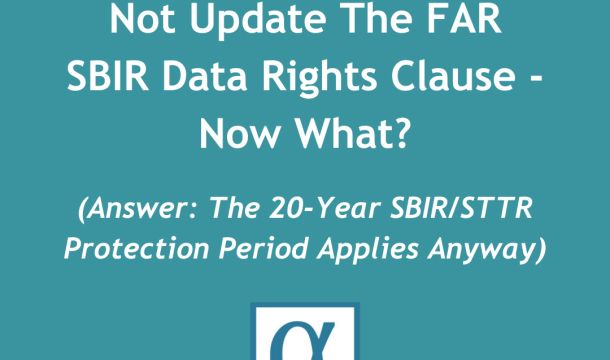The GovCon Bulletin™
Taking A Deep Dive Into Lost Creek: The SBA’s Curtailment of the Ostensible Subcontractor Rule & Joint Venture Doughnut Holes
Recently, the SBA's Office of Hearings and Appeals issued a decision sustaining, in part, a protest over the SBA's size determination of a purported ostensible subcontractor joint venture. In this edition of The GovCon Bulletin,™ we take a deep dive into the decision, which as we explain below, is particularly informative to small business government contractors since the SBA chose to announce during the protest proceedings its intent to revise its regulations to curtail the application of the "ostensible subcontractor rule."
In Size Appeal of Lost Creek Holdings, LLC, Lost Creek Holdings LLC (Lost Creek) protested two awards made by the Florida Army National Guard (ANG) to LifeHealth LLC (LifeHealth) under two separate Requests for Quotation (RFQ’s) for Women-Owned Small Business (WOSB) set-aside acquisitions. ANG’s Contracting Officer (CO) referred both protests to the SBA Area Office (Area Office), which then issued size determinations that LifeHealth was an eligible small business. Lost Creek then appealed the Area Office’s size determinations to the SBA’s Office of Hearings and Appeals (OHA).
Lost Creek largely made the same arguments in its opposition to both awards during the proceedings before the Area Office and OHA. Apart from arguing unsuccessfully that LifeHealth and its subcontractor, Dentrust Dental International, Inc. (Dentrust), each individually were not small businesses, Lost Creek insisted that LifeHealth and Dentrust were “affiliates.”
As we noted in our complimentary primer on joint ventures, Using Joint Ventures To Capture Federal Government Contracting Opportunities, Second Edition (sign up to receive our free primer here), a finding of “affiliation” between two or more businesses triggers a particular and sometimes fatal kind of treatment for purposes of determining whether a business meets a small business size standard for a contract. Specifically, under 13 CFR 121.103(a)(6), in determining the size of a business, the SBA aggregates or counts all revenues or employees of a business and all of its affiliates. Consequently, a finding of affiliation between a contractor and any other entity or entities will cause the contractor to be ineligible for a small business contract if, collectively, the contractor and its “affiliates” exceed the small business size standard of the contract. The SBA’s regulations, moreover, set out several grounds on which businesses may be found to be affiliates. Indeed, in the proceedings before the Area Office and OHA, Lost Creek argued that LifeHealth and Dentrust were affiliates based on several of those grounds.
First, Lost Creek argued that the businesses were affiliated under the SBA’s "ostensible subcontractor rule." 13 CFR 121.103(h)(4) states that a contractor and its “ostensible subcontractor” are treated as joint venturers, and therefore affiliates, for size determination purposes. The SBA regulation goes on to state that an ostensible subcontractor is a subcontractor that is not a similarly situated entity and performs primary and vital requirements of a contract, or of an order, or is a subcontractor upon which the prime contractor is unusually reliant. Lost Creek argued that LifeHealth was unusually reliant on Dentrust to perform the contract and that Dentrust is not a women-owned small business.
Lost Creek also argued, alternatively, that LifeHealth and Dentrust should also be considered affiliates based on their “identity of interests.” SBA regulations state that affiliation may arise among two or more entities with an identify of interest, including “firms that are economically dependent through contractual or other relationships.” 13 CFR 121.103(f). Lost Creek argued that LifeHealth and Dentrust shared an identity of interest because LifeHealth, in awarding 25 subcontracts to Dentrust, was economically dependent on Dentrust, which also performed on 34 of LifeHealth's contracts that constituted 82% of LifeHealth's revenues.
Lastly, Lost Creek argued that LifeHealth and Dentrust were “de facto” or “implicit” joint ventures that did not meet the requirements for the application of any of the joint venture exceptions to affiliation.
As we explain in our joint venture primer, under 13 CFR 121.103(h)(2) joint venture partners are generally deemed to be affiliated with each other for purposes of the size standard under a contract, unless their joint venture falls within one of three joint venture categories excepted from affiliation. In addition, under 13 CFR 121.103(h), all joint ventures must comply with certain prerequisites to remain eligible for any of the joint venture exceptions to affiliation, including these four prerequisites cited by Lost Creek: (i) they must put their joint venture arrangement in writing; (ii) they must do business under the name of the joint venture; (iii) they must identify the joint venture in SAM; and (iv) they must meet the “3-in-2” contract award rule. Under that rule, a joint venture may not be awarded more than three contracts over a two-year period, without the partners to the joint venture being deemed affiliated for all purposes. Although the same parties are permitted to enter into multiple joint ventures, the SBA’s regulation cautions against sustained, long-term serial joint ventures by providing that “at some point...a longstanding inter-relationship or contractual dependence between the same joint venture partners will lead to a finding of general affiliation between and among them." 13 CFR 121.103(h).
Lost Creek argued that the LifeHealth and Dentrust joint venture should be subject to affiliation because it failed to comply with the four prerequisites for any exception to affiliation and, alternatively, comprised a longstanding inter-relationship or contractual dependence among joint venture partners.
Ostensible Subcontractor Joint Ventures Are - For The Time Being - Not Eligible For Joint Venture Affiliation Exceptions Under 13 CFR 121.103(h)(3)
Addressing Lost Creek’s assertion of an ostensible subcontractor relationship, OHA rejected arguments by the Area Office and the SBA’s General Counsel over the interaction between the regulations concerning one of the three categories of joint ventures excepted from affiliation – namely joint ventures made up of small businesses – and the ostensible subcontractor rule.
As stated above, 13 CFR 121.103(h)(4) provides that “[a] contractor and its ostensible subcontractor are treated as joint venturers, and therefore affiliates, for size determination purposes.” Meanwhile, under 13 CFR 121.103(h)(3)(i), a joint venture of two or more businesses “may submit an offer as a small business for a Federal procurement, subcontract or sale so long as each concern is small under the size standard corresponding to the NAICS code assigned to the contract.”
In issuing its size determinations, the Area Office side-stepped the issue of whether LifeHealth was, in fact, unusually reliant on Dentrust and thus in an ostensible subcontractor relationship. Rather, it concluded that Dentrust was a small business and that even if LifeHealth and Dentrust were affiliated as joint venturers under the ostensible subcontractor rule, the joint venture would be considered a small business under 13 CFR 121.103(h)(3)(i). Consequently, the Area Office decided an ostensible subcontractor analysis was unnecessary.
On appeal to OHA, the SBA’s Office of General Counsel filed agency comments in support of the size determinations. In support, the SBA followed a “kitchen sink” approach pointing first to its regulation under 13 CFR 125.8(b)(1) stating that joint ventures do not have to be in any particular form to qualify as a small business. The SBA insisted this regulation extends to prime-subcontractor arrangements that are treated as joint ventures under the ostensible subcontractor rule. The SBA also cited again the affiliation exception under 13 CFR 121.103(h)(i) for joint ventures among small businesses, and pointed to recent regulation changes that lifted limitations on small business contractor subcontracts with other small businesses.
The SBA’s last-ditch effort to support the Area Office's size determinations is most revealing for the future of the ostensible subcontractor rule. In the face of the rule’s clear and explicit instruction that ostensible subcontractors and their primes would be treated not only as joint ventures but also “as affiliates,” the SBA argued that in its recent revisions to the affiliation regulations it “should have changed” not only the ostensible subcontractor rule, but also the regulation under 13 CFR 121.103(h)(2). That regulation provides a clear and explicit general rule that businesses submitting offers as joint ventures will be deemed affiliated during contract performance, and specifies only one place to go to for any exception to the general rule. Specifically, it points to paragraph (h)(3), which sets forth the three categories of joint ventures excepted from joint venture affiliation. The SBA argued that retaining the general joint venture affiliation rule and the ostensible subcontractor rule in their present form “was merely an oversight,” that they should be disregarded as “vestiges” of a prior regulatory scheme, and that the SBA intended to delete the provisions in the “near future.” The SBA further stated that it intends that all joint ventures in which each venturer is small will be treated as small for any small business procurement.
OHA, however, would have none of it. Finding that the ostensible subcontractor rule and 13 CFR 121.103(h)(i) were issued in the same rule-making, OHA rejected the argument that one negates the other. OHA also pointed to the ostensible subcontractor rule’s specific and explicit instruction that prime contractors and subcontractors in an ostensible subcontractor relationship are affiliated for size determination purpose. Moreover, OHA reminded the SBA that nothing in the Administrative Procedure Act permits an agency to ignore its own regulation by declaring it a vestige. OHA ultimately concluded that that the ostensible subcontractor rule remained in full force and effect and that the Area Office erred in not conducting an ostensible subcontractor analysis.
Nevertheless, small business subcontractors should look out for changes in the affiliation regulation under 13 CFR 121.103(h) that the SBA has signaled are coming. Specifically, it appears that the SBA will, at a minimum, curtail the application of the ostensible subcontractor rule so it does not apply to prime-subcontractor relationships between small businesses.
The Key Question For Identity of Interest Affiliation Based On Economic Dependence: How Does The Money Flow?
OHA rejected Lost Creek’s argument that the number of subcontracts between LifeHealth and Dentrust made them affiliated based on the economic dependence prong of the identity of interest rule under 13 CFR 121.103(f). In doing so, OHA essentially turns a factor that gives rise to a presumption of economic dependence in certain circumstances into a threshold for determining economic dependence in all instances.
The SBA’s regulation on affiliation based on identify of interest under 13 CFR 121.103(f) states that affiliation “may arise” when entities have an identity of interest. The SBA regulation elaborates further that businesses that have identical or substantially identical business or economic interests may be treated as one party with their interests aggregated, and sets forth examples of such interests, including when firms “are economically dependent through contractual or other relationships.”
Additionally, the regulation provides that the SBA may “presume” an identity of interest based on economic dependence if a “concern in question” derives 70% or more of its receipts from another concern over the prior three years. Pointing mainly to this presumption’s requirement that the “concern in question” obtain receipts from the entity it is alleged to be affiliated with, OHA concluded that under the regulation any finding of an identity of interest based on economic dependence “requires a revenue stream...to flow” from an alleged affiliate to the protested contractor.
Thus, under OHA's ruling, no matter how many times a small business teams up with another business in a prime-subcontractor relationship, including with a large business, the SBA cannot deem the small business to be economically dependent on the other business as long as federal government money flows down from the small business as prime contractor to the other business as subcontractor.
The Perpetual Ostensible Subcontracting Doughnut Hole
As stated, Lost Creek argued that LifeHealth and Dentrust should be deemed to be affiliated because the extensive contracting between them violated the "3-in-2" rule, and alternatively, comprised a longstanding inter-relationship or contractual dependence among joint venture partners. In response, the Area Office stuck to formality and concluded that the "3-in-2" limitation only applies when the offeror has submitted an offer "as a joint venture." (Never mind that the affiliation exception for joint ventures among small businesses relied on by the Area Office to find the LifeHealth/Dentrust joint venture was a small business also applies only when parties submit offers as a joint venture.) The Area Office's response prompted Lost Creek to argue on appeal that the Area Office's decision not to apply the "3-in-2" rule to an ostensible subcontract joint venture created a "doughnut hole" that nullified the prerequisites for the application of the joint venture affiliation exceptions under 13 CFR 121.103(h), including the requirement that the joint venture agreement be in writing and the joint venture be identified separately and registered in SAM.
Although OHA did not address the issue in detail, in remanding the case to the Area Office on the issue of whether an ostensible subcontractor relationship exists, OHA instructed it to "also" consider Lost Creek's contention that LifeHealth and Dentrust were engaged in a longstanding inter-relationship or had developed a contractual dependence. OHA's decision implies, therefore, that ostensible subcontractor joint ventures must comply not only with the rule against longstanding perpetual joint ventures, but also the "3-in-2" rule and as well as each of the remaining other prerequisites under 13 CFR 121.103(h) for the application of any joint venture exceptions to affiliation.
To read the Lost Creek decision go here. To read other articles from The GovCon Bulletin™ go here.



